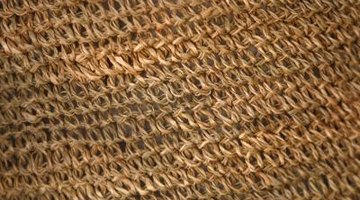The Advantages & Disadvantages of Natural Fabric Rugs
Your decisions on purchasing a rug for your home aren't limited simply to color or pattern. The rug's material can make a significant difference in the way that it looks, feels and performs in your home. Natural fiber rugs as the name suggests are made from natural materials such as plant fibers, so they are an ideal option if you are looking for a green option. Before you purchase a natural fiber rug, consider both the advantages and disadvantages so you can be certain that it is the right choice for your home.
Advantage: Health Benefits

Natural fiber rugs carry health benefits that can make them appealing to consumers with health issues or concerns. Because they are made from natural materials, natural fiber rugs do not contain harmful chemicals. Volatile compounds in the fibers of synthetic rugs may emit gases that are potentially hazardous to health. The gases given off by synthetic rugs can be particularly harmful to children, so natural fabric rugs are an ideal floor covering for a nursery or child’s bedroom, according to green interior designer Lori Dennis in her book “Green Interior Design.” In addition, natural fabric rugs such as wool and cotton are more effective in holding onto dust particles so they do not float in the air and aggravate allergies. They are also helpful in removing contaminants like nitrogen dioxide, formaldehyde and sulfur dioxide from your home’s air so your family doesn’t inhale them.
Advantage: Eco-Friendly
If you are interested in an eco-friendly rug, natural fabric carpeting is an ideal option. Unlike synthetic rugs, natural fiber carpets are biodegradable so they create less waste. They can also be recycled or made from recycled materials, which makes them a green home decor item. In addition, the plant materials that are used to make natural fabric rugs are rapidly renewable, so the materials can be collected again and again without damaging the ecosystem.
Disadvantage: Stain Easily
Because they are made from natural materials, natural fabric rugs are highly absorbent. As a result, they stain easily if you spill liquids or foods on them. Even water can stain some natural fabric rugs such as silk or sea grass. If you notice a stain on your natural fabric rug, clean it as soon as possible to avoid permanent discoloration. Their tendency to hold onto moisture also puts natural fiber rugs at risk for mold growth, so it’s best to avoid using natural fabric rugs in damp areas such as a basement.
Disadvantage: Coarse Texture
While wool and silk carpets have a soft, comfortable feel under foot, other natural plant fiber rugs can have a rough, coarse texture. In particular, sea grass, cotton, jute, coir and sisal have a scratchy feel on bare feet. As a result, they are not a good option for bedrooms or other areas where children may play on the floor. In addition, the coarse texture may prove a temptation to pets, which may claw at the fabric until it comes apart or sheds. Jute, sisal and coir are especially known for their tendency to shed.
References
Writer Bio
Based in New York City, Jennifer Blair has been covering all things home and garden since 2001. Her writing has appeared on BobVila.com, World Lifestyle, and House Logic. Blair holds a Bachelor of Arts in Writing Seminars from the Johns Hopkins University in Baltimore, Maryland.
Photo Credits
- Hemera Technologies/AbleStock.com/Getty Images
More Articles



